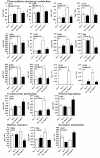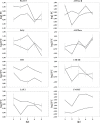Proteomic characterization of the Rph15 barley resistance gene-mediated defence responses to leaf rust
- PMID: 23167439
- PMCID: PMC3541957
- DOI: 10.1186/1471-2164-13-642
Proteomic characterization of the Rph15 barley resistance gene-mediated defence responses to leaf rust
Abstract
Background: Leaf rust, caused by the biotrophic fungal pathogen Puccinia hordei, is one of the most important foliar disease of barley (Hordeum vulgare) and represents a serious threat in many production regions of the world. The leaf rust resistance gene Rph15 is of outstanding interest for resistance breeding because it confers resistance to over 350 Puccinia hordei isolates collected from around the world. Molecular and biochemical mechanisms responsible for the Rph15 effectiveness are currently not investigated. The aim of the present work was to study the Rph15-based defence responses using a proteomic approach.
Results: Protein pattern changes in response to the leaf rust pathogen infection were investigated in two barley near isogenic lines (NILs), Bowman (leaf rust susceptible) and Bowman-Rph15 (leaf rust resistant), differing for the introgression of the leaf rust resistance gene Rph15. Two infection time points, 24 hours and four days post inoculation (dpi), were analysed. No statistically significant differences were identified at the early time point, while at 4 dpi eighteen protein spots were significantly up or down regulated with a fold-change equal or higher than two in response to pathogen infection. Almost all the pathogen-responsive proteins were identified in the Bowman-Rph15 resistant NIL. Protein spots were characterized by LC-MS/MS analysis and found to be involved in photosynthesis and energy metabolism, carbohydrate metabolism, protein degradation and defence. Proteomic data were complemented by transcriptional analysis of the respective genes. The identified proteins can be related to modulation of the photosynthetic apparatus components, re-direction of the metabolism to sustain defence responses and deployment of defence proteins.
Conclusions: The identification of leaf rust infection-modulated defence responses restricted to the resistant NIL support the hypothesis that basal defence responses of Bowman, but not the Rph15 resistance gene-based ones, are suppressed or delayed by pathogen effectors to levels below the detection power of the adopted proteomic approach. Additionally, Rph15-mediated resistance processes identified mainly resides on a modulation of primary metabolism, affecting photosyntesis and carbohydrate pool.
Figures





Similar articles
-
BED domain-containing NLR from wild barley confers resistance to leaf rust.Plant Biotechnol J. 2021 Jun;19(6):1206-1215. doi: 10.1111/pbi.13542. Epub 2021 Mar 6. Plant Biotechnol J. 2021. PMID: 33415836 Free PMC article.
-
Conversion of an amplified fragment length polymorphism marker into a co-dominant marker in the mapping of the Rph15 gene conferring resistance to barley leaf rust, Puccinia hordei Otth.Theor Appl Genet. 2004 Feb;108(4):712-9. doi: 10.1007/s00122-003-1470-2. Epub 2003 Oct 2. Theor Appl Genet. 2004. PMID: 14523515
-
Allele characterization of genes required for rpg4-mediated wheat stem rust resistance identifies Rpg5 as the R gene.Phytopathology. 2013 Nov;103(11):1153-61. doi: 10.1094/PHYTO-01-13-0030-R. Phytopathology. 2013. PMID: 23841622
-
Leaf rust of cultivated barley: pathology and control.Annu Rev Phytopathol. 2015;53:565-89. doi: 10.1146/annurev-phyto-080614-120324. Epub 2015 Jun 5. Annu Rev Phytopathol. 2015. PMID: 26047566 Review.
-
Molecular genetics of leaf rust resistance in wheat and barley.Theor Appl Genet. 2020 Jul;133(7):2035-2050. doi: 10.1007/s00122-020-03570-8. Epub 2020 Mar 3. Theor Appl Genet. 2020. PMID: 32128617 Review.
Cited by
-
The quest for tolerant varieties: the importance of integrating "omics" techniques to phenotyping.Front Plant Sci. 2015 Jul 9;6:448. doi: 10.3389/fpls.2015.00448. eCollection 2015. Front Plant Sci. 2015. PMID: 26217344 Free PMC article. Review.
-
Omics for the Improvement of Abiotic, Biotic, and Agronomic Traits in Major Cereal Crops: Applications, Challenges, and Prospects.Plants (Basel). 2021 Sep 23;10(10):1989. doi: 10.3390/plants10101989. Plants (Basel). 2021. PMID: 34685799 Free PMC article. Review.
-
Mineral nitrogen sources differently affect root glutamine synthetase isoforms and amino acid balance among organs in maize.BMC Plant Biol. 2015 Apr 3;15:96. doi: 10.1186/s12870-015-0482-9. BMC Plant Biol. 2015. PMID: 25886826 Free PMC article.
-
A first step toward the development of a barley NAM population and its utilization to detect QTLs conferring leaf rust seedling resistance.Theor Appl Genet. 2014 Jul;127(7):1513-25. doi: 10.1007/s00122-014-2315-x. Epub 2014 May 6. Theor Appl Genet. 2014. PMID: 24797143
-
Deciphering the Omics of Plant-Microbe Interaction: Perspectives and New Insights.Curr Genomics. 2020 Aug;21(5):343-362. doi: 10.2174/1389202921999200515140420. Curr Genomics. 2020. PMID: 33093798 Free PMC article. Review.
References
-
- Weerasena JS, Steffenson BJ, Falk AB. Conversion of an amplified fragment length polymorphism marker into a co-dominant marker in the mapping of the Rph15 gene conferring resistance to barley leaf rust, Puccinia hordei Otth. Theor Appl Genet. 2004;108:712–719. doi: 10.1007/s00122-003-1470-2. - DOI - PubMed
-
- Cotterill PJ, Rees RG, Platz GJ. Response of Australian barley cultivars to leaf rust (Puccinia hordei) Aust J Exp Agric. 1994;34:783–788. doi: 10.1071/EA9940783. - DOI
-
- Heath MC. Signalling between pathogenic rust fungi and resistant or susceptible host plants. Annals of Bot. 1997;80:713–720. doi: 10.1006/anbo.1997.0507. - DOI

